Collective Bargaining Report: Issues, Changes, and Recommendations
VerifiedAdded on 2023/04/20
|14
|1911
|374
Report
AI Summary
This report provides a comprehensive analysis of collective bargaining, exploring its definition, strategies, and significance in the workplace. It delves into the challenges faced by both employers and employees during negotiations, including wage bargaining, job security, and productivity concerns. The report offers examples of collective bargaining in various industries and discusses the factors that influence the process, such as weak unions and political interference. It also examines how issues are addressed from the perspectives of management and unions, including considerations of human resource policies, occupational environment, and proposal preparations. Furthermore, the report highlights the changes in collective bargaining over time, including improvements in working conditions, and the reasons behind these changes. Finally, it presents findings and recommendations, emphasizing the importance of collective bargaining for trade unions, employees, and companies, and concludes by summarizing the benefits of the process for all parties involved.
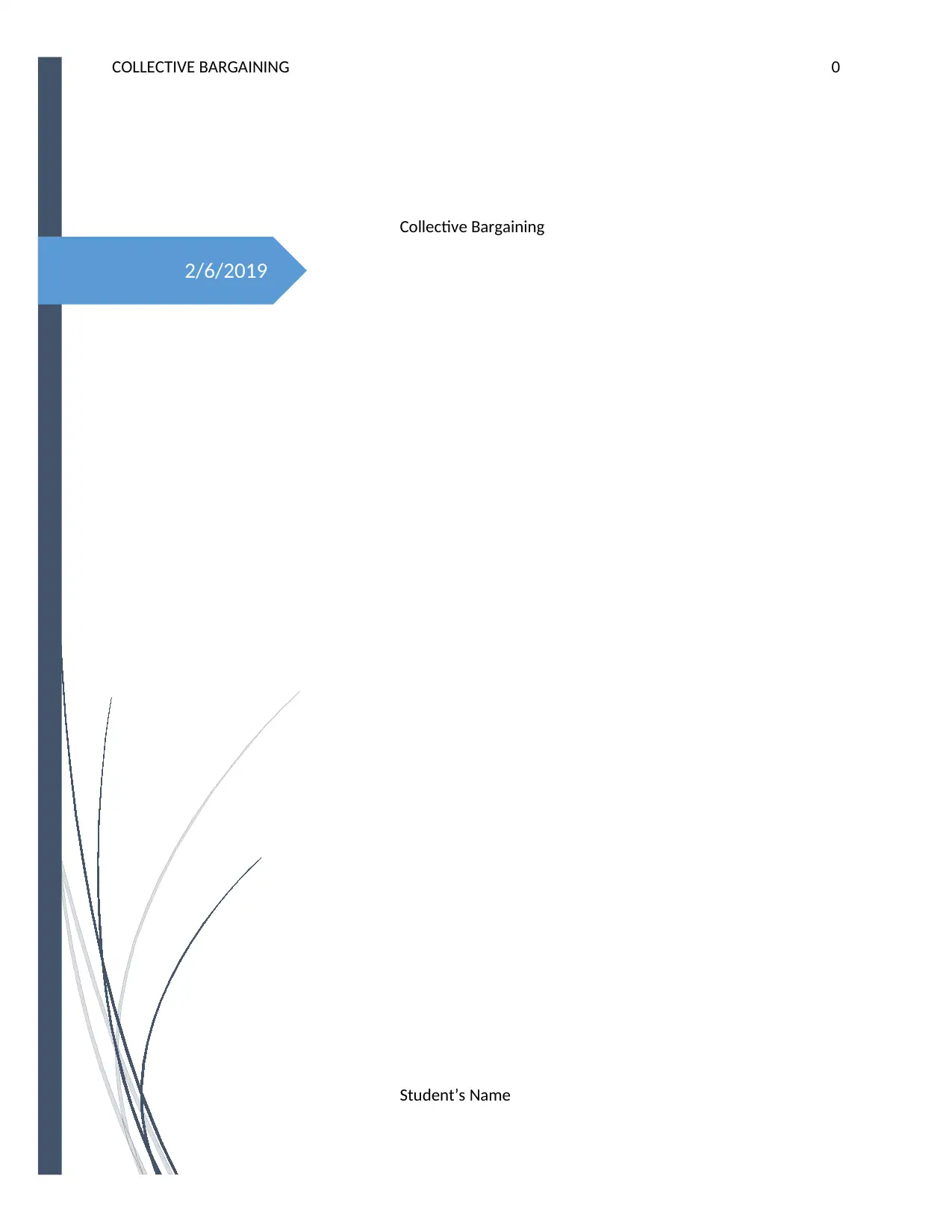
2/6/2019
COLLECTIVE BARGAINING 0
Collective Bargaining
Student’s Name
COLLECTIVE BARGAINING 0
Collective Bargaining
Student’s Name
Paraphrase This Document
Need a fresh take? Get an instant paraphrase of this document with our AI Paraphraser
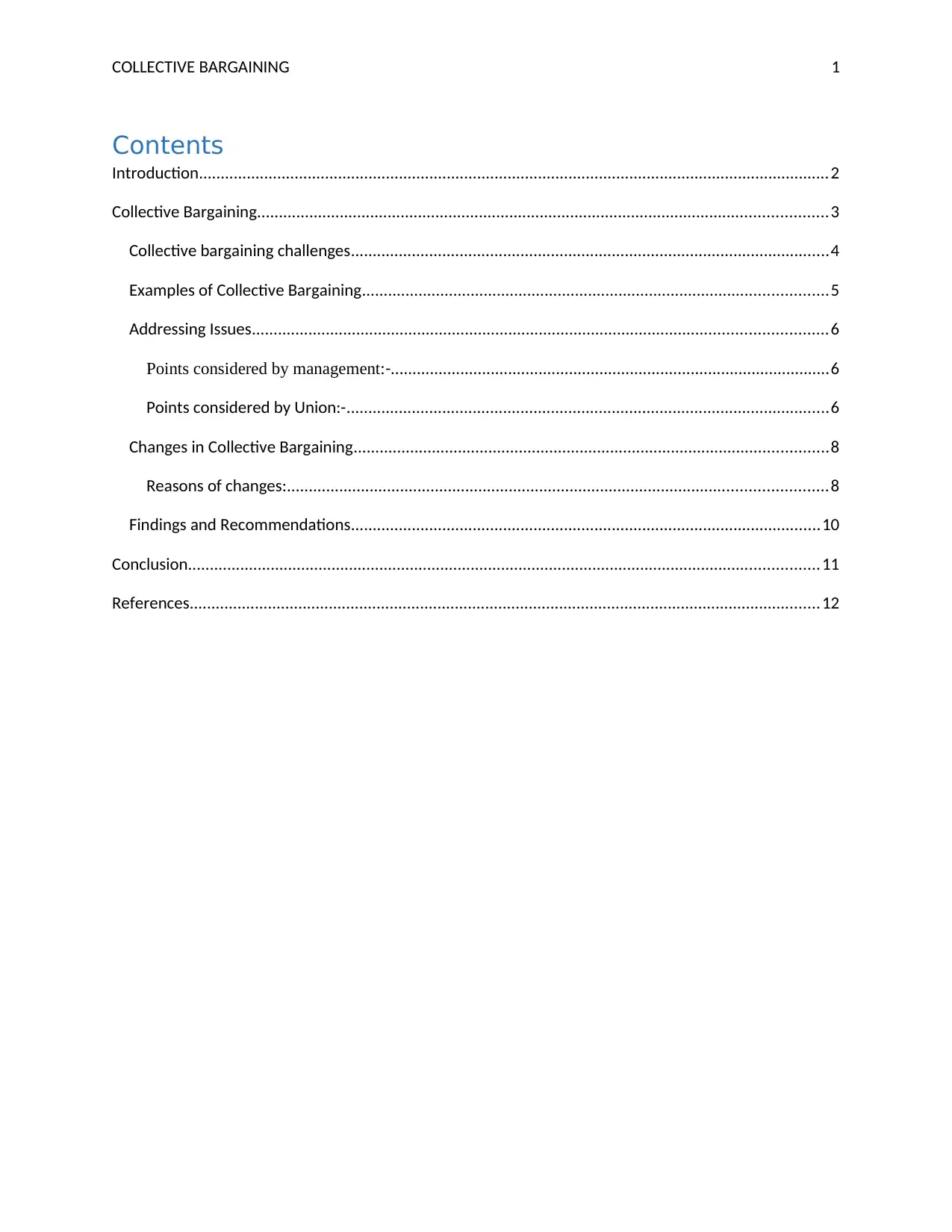
COLLECTIVE BARGAINING 1
Contents
Introduction.................................................................................................................................................2
Collective Bargaining...................................................................................................................................3
Collective bargaining challenges..............................................................................................................4
Examples of Collective Bargaining...........................................................................................................5
Addressing Issues....................................................................................................................................6
Points considered by management:-.....................................................................................................6
Points considered by Union:-...............................................................................................................6
Changes in Collective Bargaining.............................................................................................................8
Reasons of changes:............................................................................................................................8
Findings and Recommendations............................................................................................................10
Conclusion.................................................................................................................................................11
References.................................................................................................................................................12
Contents
Introduction.................................................................................................................................................2
Collective Bargaining...................................................................................................................................3
Collective bargaining challenges..............................................................................................................4
Examples of Collective Bargaining...........................................................................................................5
Addressing Issues....................................................................................................................................6
Points considered by management:-.....................................................................................................6
Points considered by Union:-...............................................................................................................6
Changes in Collective Bargaining.............................................................................................................8
Reasons of changes:............................................................................................................................8
Findings and Recommendations............................................................................................................10
Conclusion.................................................................................................................................................11
References.................................................................................................................................................12
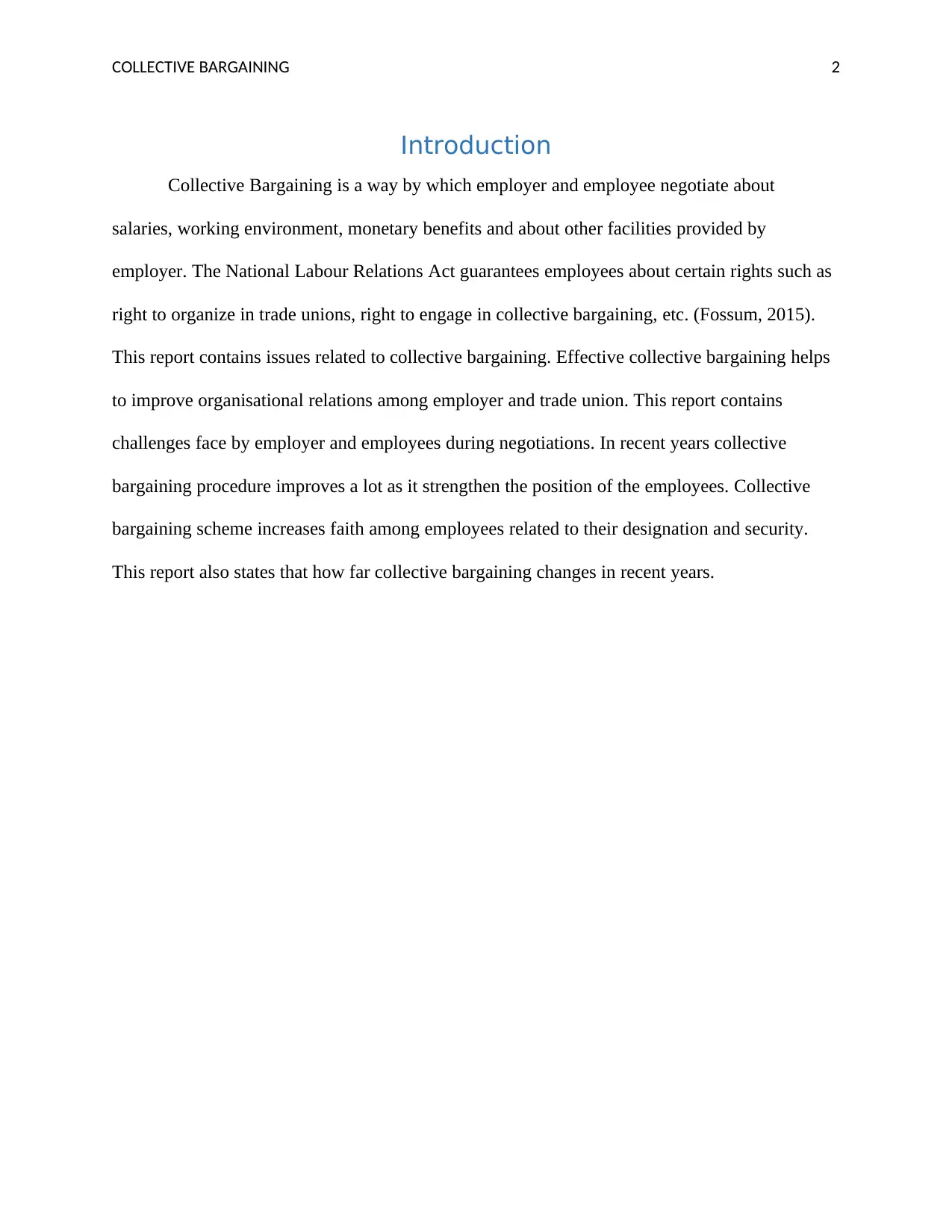
COLLECTIVE BARGAINING 2
Introduction
Collective Bargaining is a way by which employer and employee negotiate about
salaries, working environment, monetary benefits and about other facilities provided by
employer. The National Labour Relations Act guarantees employees about certain rights such as
right to organize in trade unions, right to engage in collective bargaining, etc. (Fossum, 2015).
This report contains issues related to collective bargaining. Effective collective bargaining helps
to improve organisational relations among employer and trade union. This report contains
challenges face by employer and employees during negotiations. In recent years collective
bargaining procedure improves a lot as it strengthen the position of the employees. Collective
bargaining scheme increases faith among employees related to their designation and security.
This report also states that how far collective bargaining changes in recent years.
Introduction
Collective Bargaining is a way by which employer and employee negotiate about
salaries, working environment, monetary benefits and about other facilities provided by
employer. The National Labour Relations Act guarantees employees about certain rights such as
right to organize in trade unions, right to engage in collective bargaining, etc. (Fossum, 2015).
This report contains issues related to collective bargaining. Effective collective bargaining helps
to improve organisational relations among employer and trade union. This report contains
challenges face by employer and employees during negotiations. In recent years collective
bargaining procedure improves a lot as it strengthen the position of the employees. Collective
bargaining scheme increases faith among employees related to their designation and security.
This report also states that how far collective bargaining changes in recent years.
⊘ This is a preview!⊘
Do you want full access?
Subscribe today to unlock all pages.

Trusted by 1+ million students worldwide
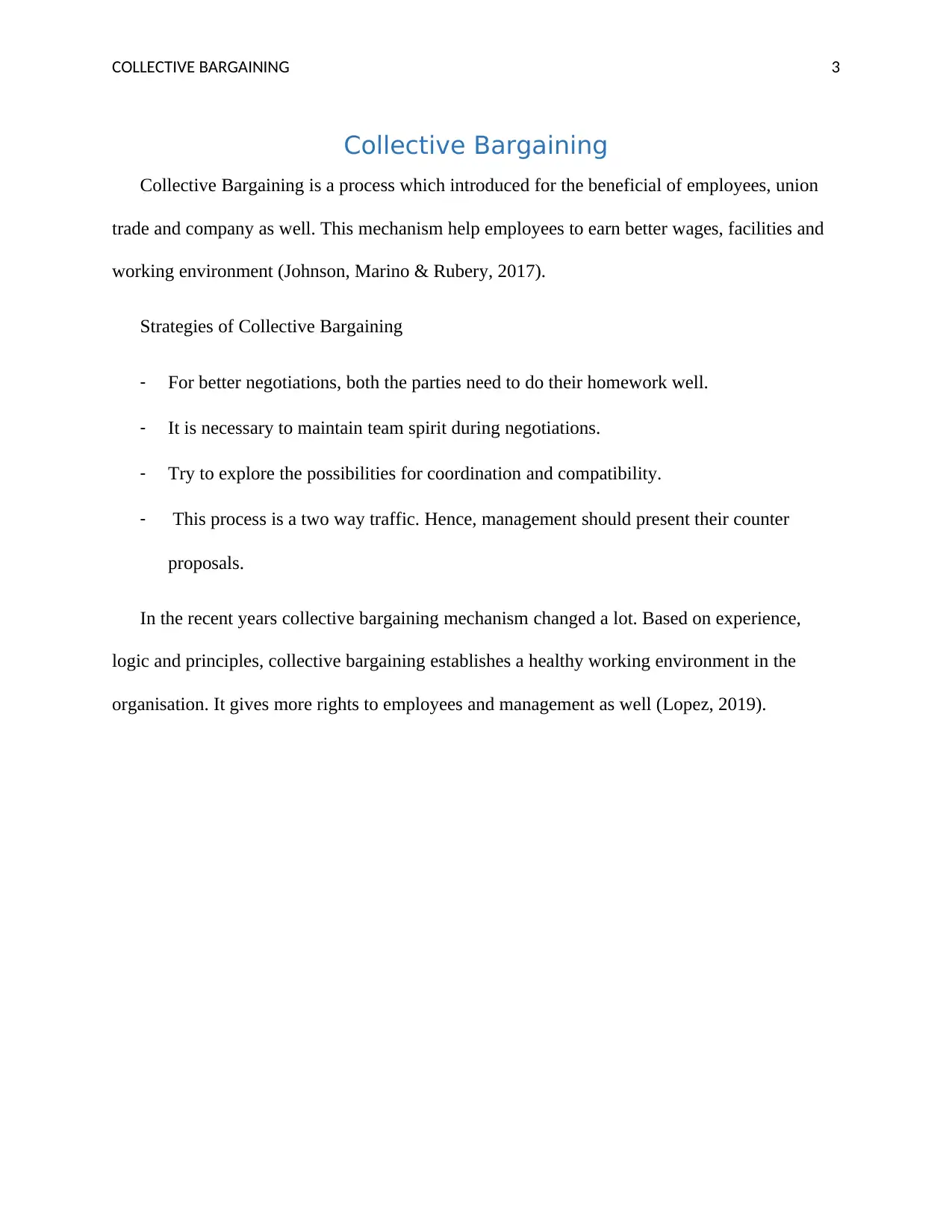
COLLECTIVE BARGAINING 3
Collective Bargaining
Collective Bargaining is a process which introduced for the beneficial of employees, union
trade and company as well. This mechanism help employees to earn better wages, facilities and
working environment (Johnson, Marino & Rubery, 2017).
Strategies of Collective Bargaining
- For better negotiations, both the parties need to do their homework well.
- It is necessary to maintain team spirit during negotiations.
- Try to explore the possibilities for coordination and compatibility.
- This process is a two way traffic. Hence, management should present their counter
proposals.
In the recent years collective bargaining mechanism changed a lot. Based on experience,
logic and principles, collective bargaining establishes a healthy working environment in the
organisation. It gives more rights to employees and management as well (Lopez, 2019).
Collective Bargaining
Collective Bargaining is a process which introduced for the beneficial of employees, union
trade and company as well. This mechanism help employees to earn better wages, facilities and
working environment (Johnson, Marino & Rubery, 2017).
Strategies of Collective Bargaining
- For better negotiations, both the parties need to do their homework well.
- It is necessary to maintain team spirit during negotiations.
- Try to explore the possibilities for coordination and compatibility.
- This process is a two way traffic. Hence, management should present their counter
proposals.
In the recent years collective bargaining mechanism changed a lot. Based on experience,
logic and principles, collective bargaining establishes a healthy working environment in the
organisation. It gives more rights to employees and management as well (Lopez, 2019).
Paraphrase This Document
Need a fresh take? Get an instant paraphrase of this document with our AI Paraphraser
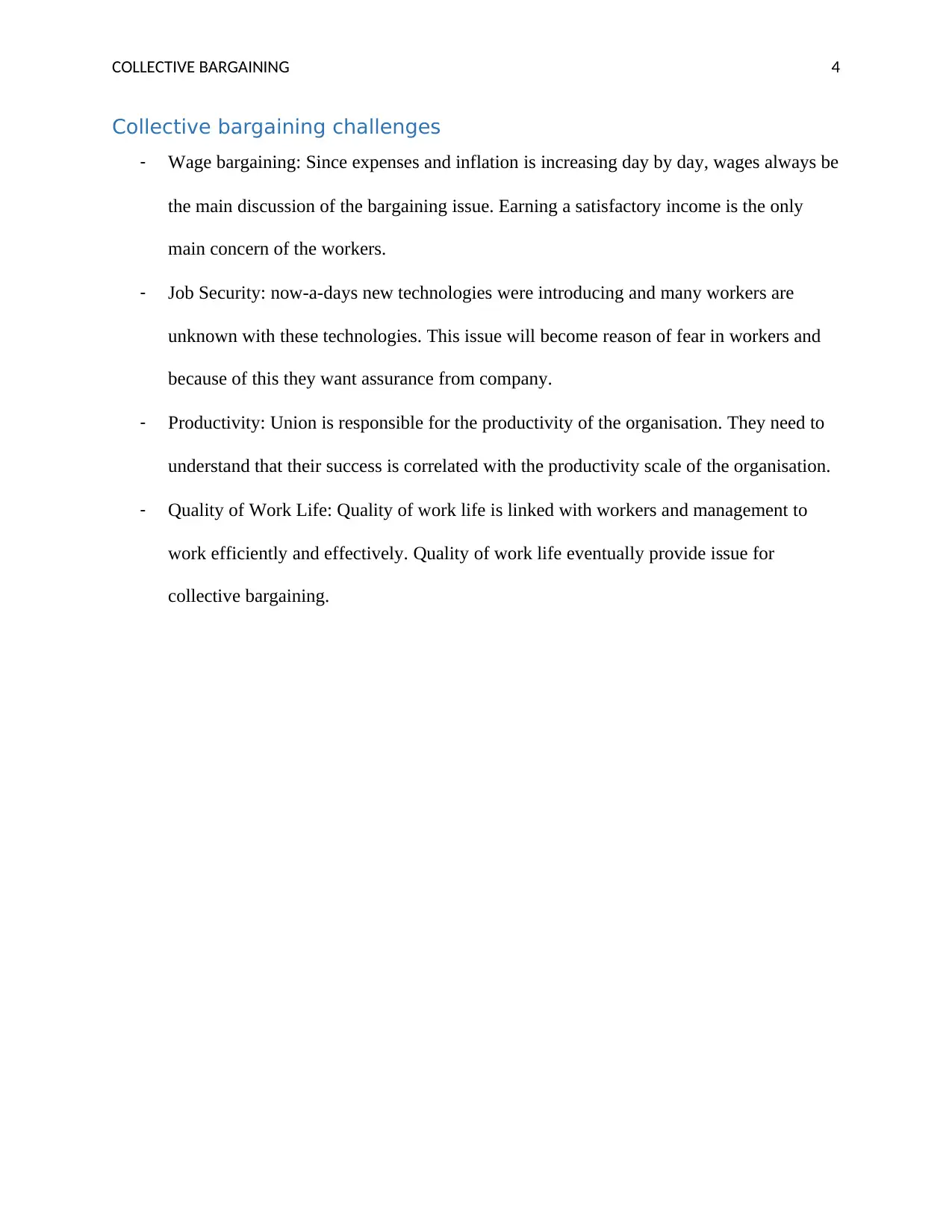
COLLECTIVE BARGAINING 4
Collective bargaining challenges
- Wage bargaining: Since expenses and inflation is increasing day by day, wages always be
the main discussion of the bargaining issue. Earning a satisfactory income is the only
main concern of the workers.
- Job Security: now-a-days new technologies were introducing and many workers are
unknown with these technologies. This issue will become reason of fear in workers and
because of this they want assurance from company.
- Productivity: Union is responsible for the productivity of the organisation. They need to
understand that their success is correlated with the productivity scale of the organisation.
- Quality of Work Life: Quality of work life is linked with workers and management to
work efficiently and effectively. Quality of work life eventually provide issue for
collective bargaining.
Collective bargaining challenges
- Wage bargaining: Since expenses and inflation is increasing day by day, wages always be
the main discussion of the bargaining issue. Earning a satisfactory income is the only
main concern of the workers.
- Job Security: now-a-days new technologies were introducing and many workers are
unknown with these technologies. This issue will become reason of fear in workers and
because of this they want assurance from company.
- Productivity: Union is responsible for the productivity of the organisation. They need to
understand that their success is correlated with the productivity scale of the organisation.
- Quality of Work Life: Quality of work life is linked with workers and management to
work efficiently and effectively. Quality of work life eventually provide issue for
collective bargaining.
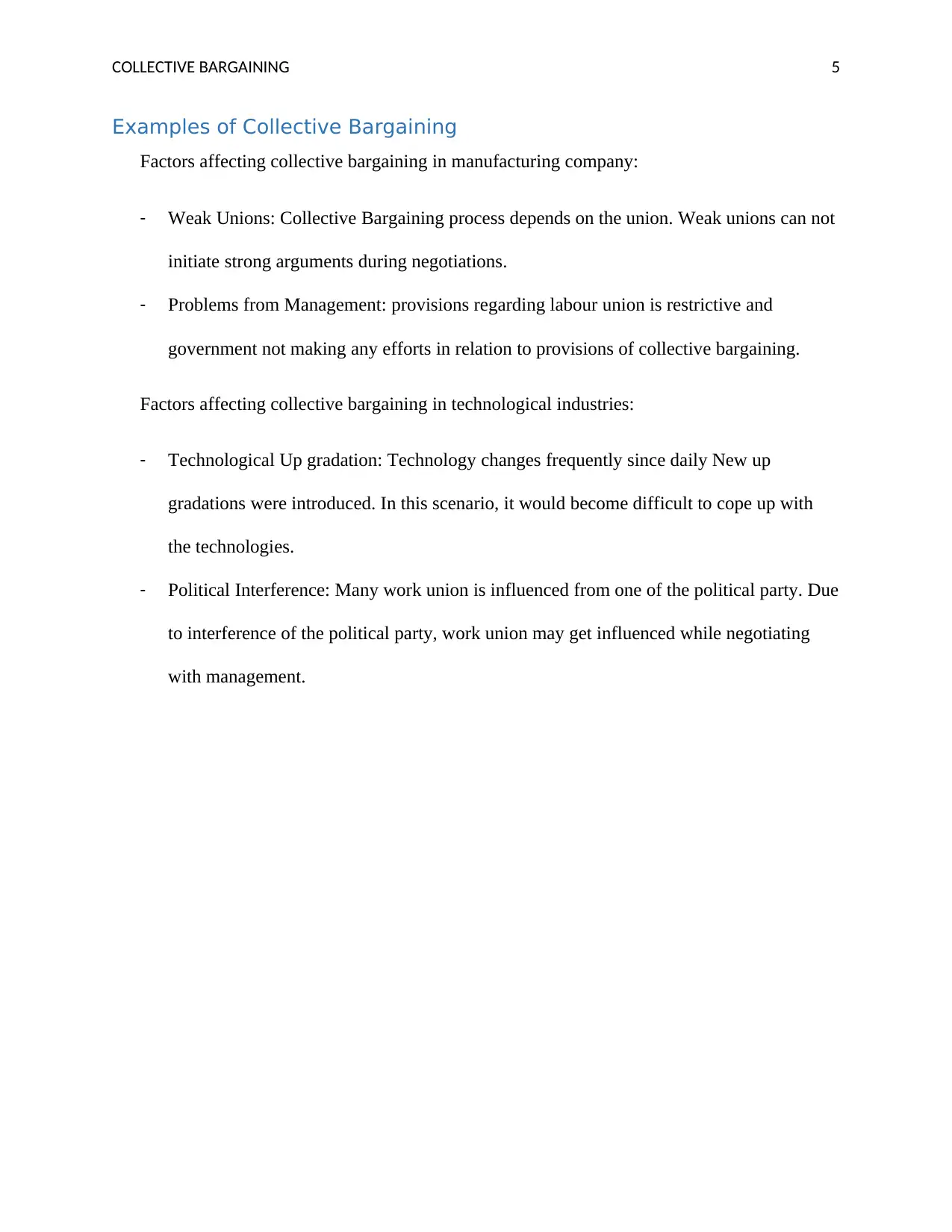
COLLECTIVE BARGAINING 5
Examples of Collective Bargaining
Factors affecting collective bargaining in manufacturing company:
- Weak Unions: Collective Bargaining process depends on the union. Weak unions can not
initiate strong arguments during negotiations.
- Problems from Management: provisions regarding labour union is restrictive and
government not making any efforts in relation to provisions of collective bargaining.
Factors affecting collective bargaining in technological industries:
- Technological Up gradation: Technology changes frequently since daily New up
gradations were introduced. In this scenario, it would become difficult to cope up with
the technologies.
- Political Interference: Many work union is influenced from one of the political party. Due
to interference of the political party, work union may get influenced while negotiating
with management.
Examples of Collective Bargaining
Factors affecting collective bargaining in manufacturing company:
- Weak Unions: Collective Bargaining process depends on the union. Weak unions can not
initiate strong arguments during negotiations.
- Problems from Management: provisions regarding labour union is restrictive and
government not making any efforts in relation to provisions of collective bargaining.
Factors affecting collective bargaining in technological industries:
- Technological Up gradation: Technology changes frequently since daily New up
gradations were introduced. In this scenario, it would become difficult to cope up with
the technologies.
- Political Interference: Many work union is influenced from one of the political party. Due
to interference of the political party, work union may get influenced while negotiating
with management.
⊘ This is a preview!⊘
Do you want full access?
Subscribe today to unlock all pages.

Trusted by 1+ million students worldwide
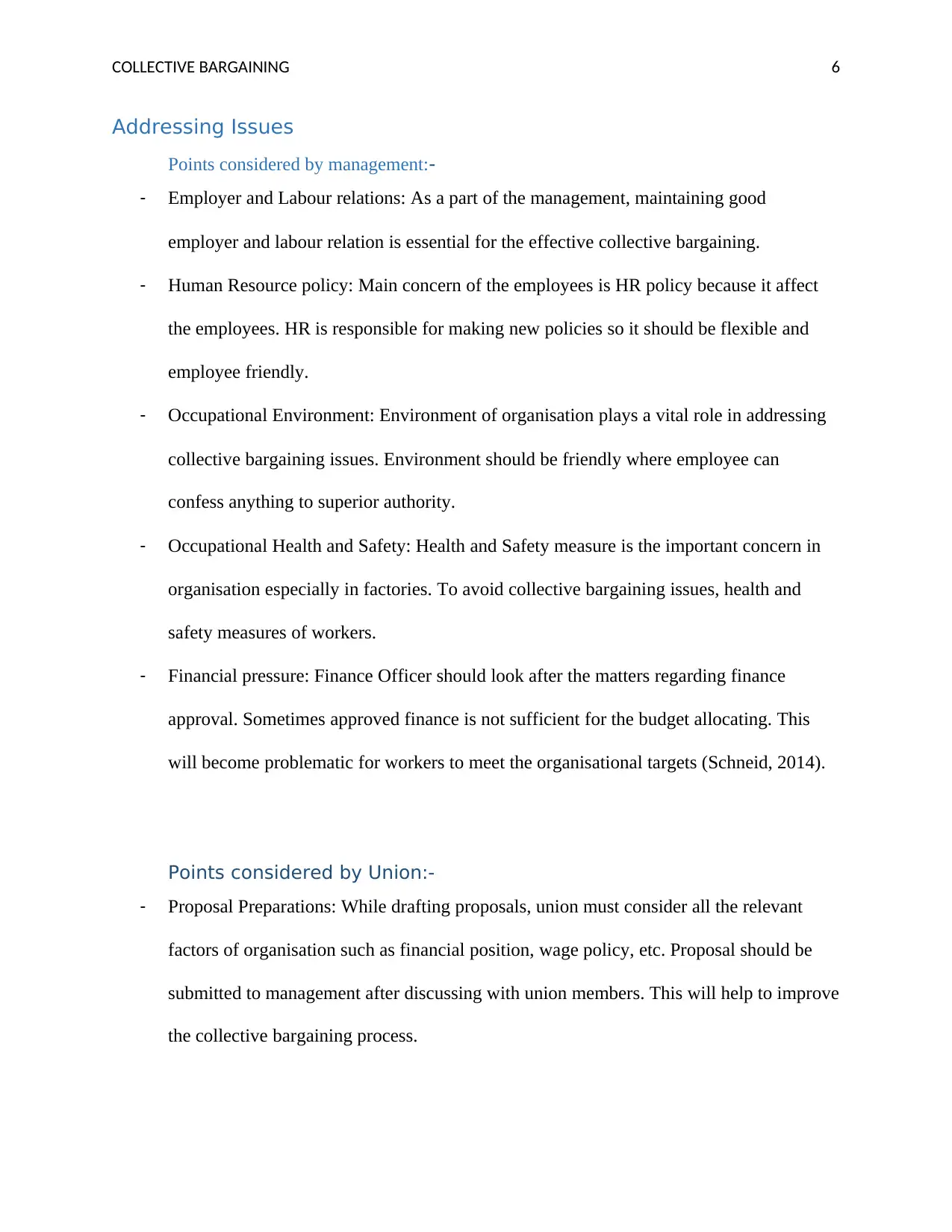
COLLECTIVE BARGAINING 6
Addressing Issues
Points considered by management:-
- Employer and Labour relations: As a part of the management, maintaining good
employer and labour relation is essential for the effective collective bargaining.
- Human Resource policy: Main concern of the employees is HR policy because it affect
the employees. HR is responsible for making new policies so it should be flexible and
employee friendly.
- Occupational Environment: Environment of organisation plays a vital role in addressing
collective bargaining issues. Environment should be friendly where employee can
confess anything to superior authority.
- Occupational Health and Safety: Health and Safety measure is the important concern in
organisation especially in factories. To avoid collective bargaining issues, health and
safety measures of workers.
- Financial pressure: Finance Officer should look after the matters regarding finance
approval. Sometimes approved finance is not sufficient for the budget allocating. This
will become problematic for workers to meet the organisational targets (Schneid, 2014).
Points considered by Union:-
- Proposal Preparations: While drafting proposals, union must consider all the relevant
factors of organisation such as financial position, wage policy, etc. Proposal should be
submitted to management after discussing with union members. This will help to improve
the collective bargaining process.
Addressing Issues
Points considered by management:-
- Employer and Labour relations: As a part of the management, maintaining good
employer and labour relation is essential for the effective collective bargaining.
- Human Resource policy: Main concern of the employees is HR policy because it affect
the employees. HR is responsible for making new policies so it should be flexible and
employee friendly.
- Occupational Environment: Environment of organisation plays a vital role in addressing
collective bargaining issues. Environment should be friendly where employee can
confess anything to superior authority.
- Occupational Health and Safety: Health and Safety measure is the important concern in
organisation especially in factories. To avoid collective bargaining issues, health and
safety measures of workers.
- Financial pressure: Finance Officer should look after the matters regarding finance
approval. Sometimes approved finance is not sufficient for the budget allocating. This
will become problematic for workers to meet the organisational targets (Schneid, 2014).
Points considered by Union:-
- Proposal Preparations: While drafting proposals, union must consider all the relevant
factors of organisation such as financial position, wage policy, etc. Proposal should be
submitted to management after discussing with union members. This will help to improve
the collective bargaining process.
Paraphrase This Document
Need a fresh take? Get an instant paraphrase of this document with our AI Paraphraser
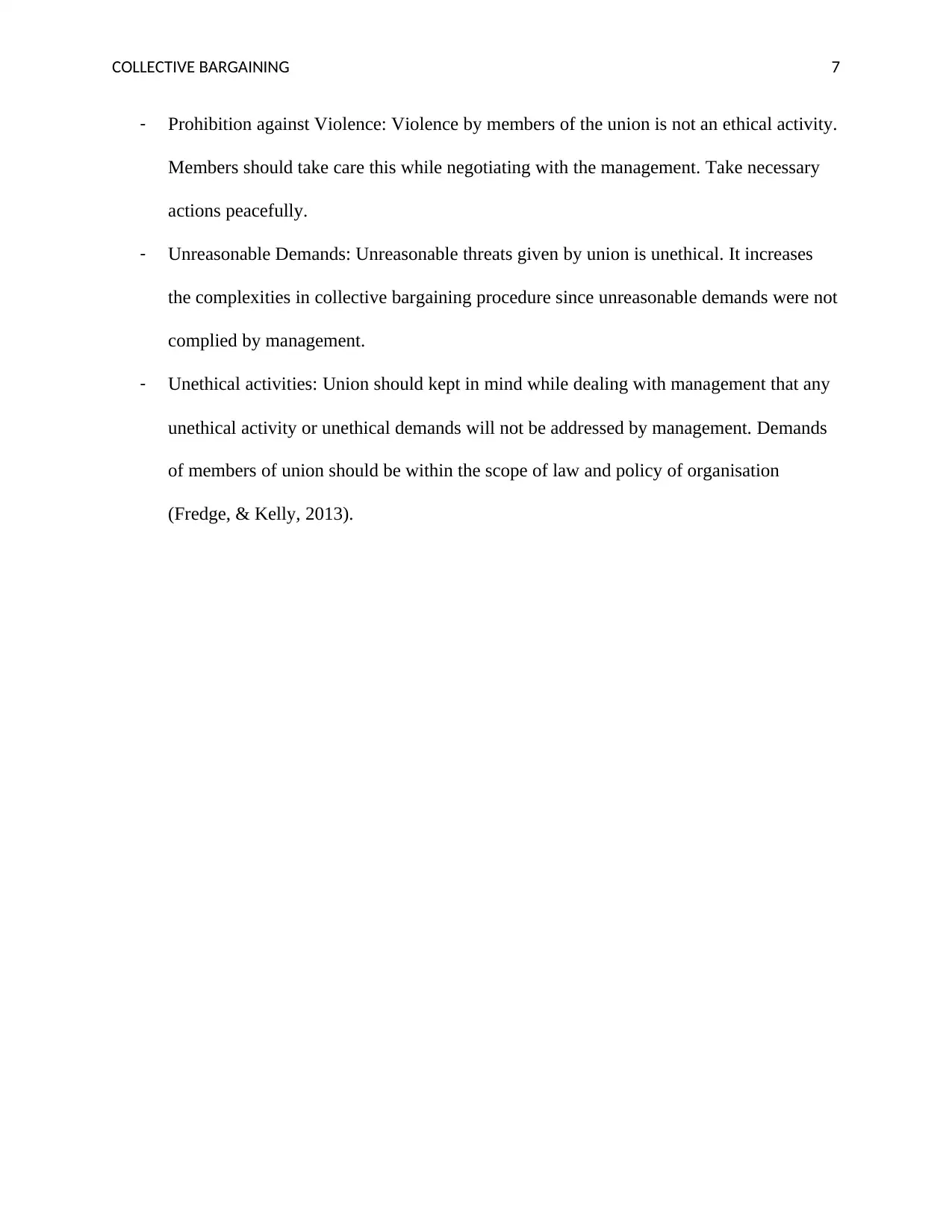
COLLECTIVE BARGAINING 7
- Prohibition against Violence: Violence by members of the union is not an ethical activity.
Members should take care this while negotiating with the management. Take necessary
actions peacefully.
- Unreasonable Demands: Unreasonable threats given by union is unethical. It increases
the complexities in collective bargaining procedure since unreasonable demands were not
complied by management.
- Unethical activities: Union should kept in mind while dealing with management that any
unethical activity or unethical demands will not be addressed by management. Demands
of members of union should be within the scope of law and policy of organisation
(Fredge, & Kelly, 2013).
- Prohibition against Violence: Violence by members of the union is not an ethical activity.
Members should take care this while negotiating with the management. Take necessary
actions peacefully.
- Unreasonable Demands: Unreasonable threats given by union is unethical. It increases
the complexities in collective bargaining procedure since unreasonable demands were not
complied by management.
- Unethical activities: Union should kept in mind while dealing with management that any
unethical activity or unethical demands will not be addressed by management. Demands
of members of union should be within the scope of law and policy of organisation
(Fredge, & Kelly, 2013).

COLLECTIVE BARGAINING 8
Changes in Collective Bargaining
Recent theory recommend old exercise of collective bargaining which states method of
negotiating with the employer is quite dominating. Employers were not easily cope up with the
requirements of employees. There is no specific law in the earlier time. Due to the lack of proper
system, employees suffered a lot. Employees were facing many issues such as anti-worker
forces, employee discrimination, sexual harassment, etc. In recent time to change the regulation
of collective bargaining, law will be introduced. Many new notifications brought to maintain
good relations among trade union and management. Now the situation is far better from the
earlier times. Organisation need to maintain good relations with employees. Apart from this
management make new policies in favour of employees and environment of organisation
(Leymon, 2011).
Reasons of changes:
- Improving working conditions throughout history.
- Collective bargaining maintain cooperation among employees and with management as
well.
- It helps to improve quality of worker’s life.
- It helps to maintain good relations with trade union.
- It helps to achieve organisational goal.
- It increases the confident of employees on organisational structure.
- It reduces conflicts and strikes.
- Collective bargaining policy is not rigid.
- Proper provisions were made regarding collective bargaining.
Changes in Collective Bargaining
Recent theory recommend old exercise of collective bargaining which states method of
negotiating with the employer is quite dominating. Employers were not easily cope up with the
requirements of employees. There is no specific law in the earlier time. Due to the lack of proper
system, employees suffered a lot. Employees were facing many issues such as anti-worker
forces, employee discrimination, sexual harassment, etc. In recent time to change the regulation
of collective bargaining, law will be introduced. Many new notifications brought to maintain
good relations among trade union and management. Now the situation is far better from the
earlier times. Organisation need to maintain good relations with employees. Apart from this
management make new policies in favour of employees and environment of organisation
(Leymon, 2011).
Reasons of changes:
- Improving working conditions throughout history.
- Collective bargaining maintain cooperation among employees and with management as
well.
- It helps to improve quality of worker’s life.
- It helps to maintain good relations with trade union.
- It helps to achieve organisational goal.
- It increases the confident of employees on organisational structure.
- It reduces conflicts and strikes.
- Collective bargaining policy is not rigid.
- Proper provisions were made regarding collective bargaining.
⊘ This is a preview!⊘
Do you want full access?
Subscribe today to unlock all pages.

Trusted by 1+ million students worldwide

COLLECTIVE BARGAINING 9
- It helps to eliminate the issues such as wage structure, concern about working
environment, etc. (Chaison, 2012).
- It helps to eliminate the issues such as wage structure, concern about working
environment, etc. (Chaison, 2012).
Paraphrase This Document
Need a fresh take? Get an instant paraphrase of this document with our AI Paraphraser
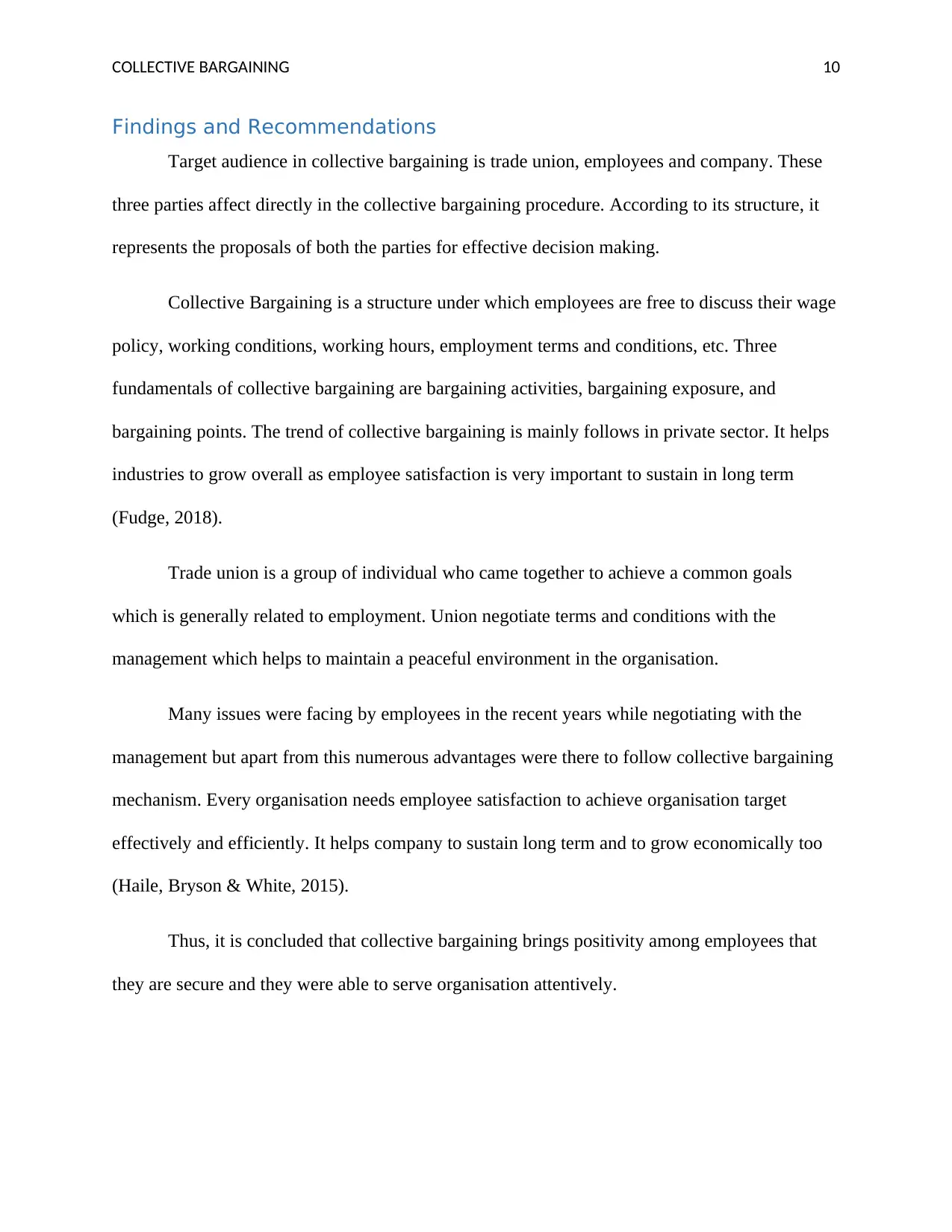
COLLECTIVE BARGAINING 10
Findings and Recommendations
Target audience in collective bargaining is trade union, employees and company. These
three parties affect directly in the collective bargaining procedure. According to its structure, it
represents the proposals of both the parties for effective decision making.
Collective Bargaining is a structure under which employees are free to discuss their wage
policy, working conditions, working hours, employment terms and conditions, etc. Three
fundamentals of collective bargaining are bargaining activities, bargaining exposure, and
bargaining points. The trend of collective bargaining is mainly follows in private sector. It helps
industries to grow overall as employee satisfaction is very important to sustain in long term
(Fudge, 2018).
Trade union is a group of individual who came together to achieve a common goals
which is generally related to employment. Union negotiate terms and conditions with the
management which helps to maintain a peaceful environment in the organisation.
Many issues were facing by employees in the recent years while negotiating with the
management but apart from this numerous advantages were there to follow collective bargaining
mechanism. Every organisation needs employee satisfaction to achieve organisation target
effectively and efficiently. It helps company to sustain long term and to grow economically too
(Haile, Bryson & White, 2015).
Thus, it is concluded that collective bargaining brings positivity among employees that
they are secure and they were able to serve organisation attentively.
Findings and Recommendations
Target audience in collective bargaining is trade union, employees and company. These
three parties affect directly in the collective bargaining procedure. According to its structure, it
represents the proposals of both the parties for effective decision making.
Collective Bargaining is a structure under which employees are free to discuss their wage
policy, working conditions, working hours, employment terms and conditions, etc. Three
fundamentals of collective bargaining are bargaining activities, bargaining exposure, and
bargaining points. The trend of collective bargaining is mainly follows in private sector. It helps
industries to grow overall as employee satisfaction is very important to sustain in long term
(Fudge, 2018).
Trade union is a group of individual who came together to achieve a common goals
which is generally related to employment. Union negotiate terms and conditions with the
management which helps to maintain a peaceful environment in the organisation.
Many issues were facing by employees in the recent years while negotiating with the
management but apart from this numerous advantages were there to follow collective bargaining
mechanism. Every organisation needs employee satisfaction to achieve organisation target
effectively and efficiently. It helps company to sustain long term and to grow economically too
(Haile, Bryson & White, 2015).
Thus, it is concluded that collective bargaining brings positivity among employees that
they are secure and they were able to serve organisation attentively.

COLLECTIVE BARGAINING 11
Conclusion
As per studies, Collective Bargaining helps in improving working conditions, pay scale
of workers, health and safety measures and other policies as well. It is a method in which
negotiations take place between trade union and company. From the above discussion, it is
concluded that there are many issues in collective bargaining but on the other hand it is more
beneficial to company and employees. Further it is concluded that in recent years it is noticed
that there is drastic change in the collective bargaining procedure.
Conclusion
As per studies, Collective Bargaining helps in improving working conditions, pay scale
of workers, health and safety measures and other policies as well. It is a method in which
negotiations take place between trade union and company. From the above discussion, it is
concluded that there are many issues in collective bargaining but on the other hand it is more
beneficial to company and employees. Further it is concluded that in recent years it is noticed
that there is drastic change in the collective bargaining procedure.
⊘ This is a preview!⊘
Do you want full access?
Subscribe today to unlock all pages.

Trusted by 1+ million students worldwide
1 out of 14
Related Documents
Your All-in-One AI-Powered Toolkit for Academic Success.
+13062052269
info@desklib.com
Available 24*7 on WhatsApp / Email
![[object Object]](/_next/static/media/star-bottom.7253800d.svg)
Unlock your academic potential
Copyright © 2020–2025 A2Z Services. All Rights Reserved. Developed and managed by ZUCOL.





